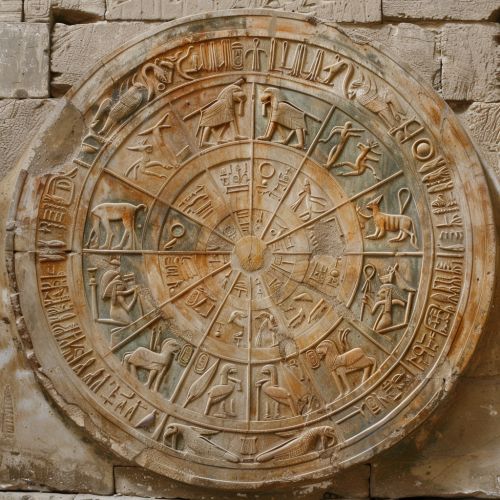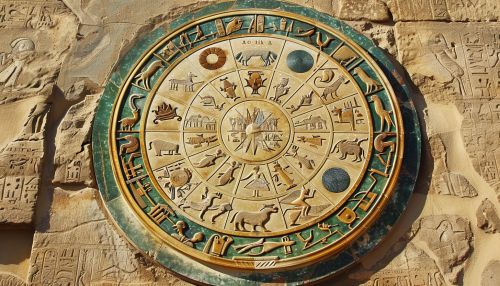Egyptian astrology: Difference between revisions
(Created page with "== Introduction == Egyptian astrology is an ancient system of divination based on the observation of celestial bodies and their influence on human affairs. Originating in the early dynastic periods of ancient Egypt, this form of astrology is deeply intertwined with the mythology, religion, and culture of the time. Unlike Western astrology, which is based on the zodiac signs, Egyptian astrology is closely linked to the deities and their associated...") |
No edit summary |
||
| Line 27: | Line 27: | ||
The Dendera Zodiac is one of the most famous artifacts of Egyptian astrology. Discovered in the Temple of Hathor at Dendera, this circular relief depicts the twelve zodiac signs along with various Egyptian deities and celestial bodies. The Dendera Zodiac is unique in that it combines elements of both Egyptian and [[Babylonian astrology|Babylonian]] astrological systems. | The Dendera Zodiac is one of the most famous artifacts of Egyptian astrology. Discovered in the Temple of Hathor at Dendera, this circular relief depicts the twelve zodiac signs along with various Egyptian deities and celestial bodies. The Dendera Zodiac is unique in that it combines elements of both Egyptian and [[Babylonian astrology|Babylonian]] astrological systems. | ||
[[Image:Detail-91313.jpg|thumb|center|The Dendera Zodiac, a circular relief depicting the twelve zodiac signs along with various Egyptian deities and celestial bodies.|class=only_on_mobile]] | |||
[[Image:Detail-91314.jpg|thumb|center|The Dendera Zodiac, a circular relief depicting the twelve zodiac signs along with various Egyptian deities and celestial bodies.|class=only_on_desktop]] | |||
=== Astrological Deities === | === Astrological Deities === | ||
Latest revision as of 20:41, 21 June 2024
Introduction
Egyptian astrology is an ancient system of divination based on the observation of celestial bodies and their influence on human affairs. Originating in the early dynastic periods of ancient Egypt, this form of astrology is deeply intertwined with the mythology, religion, and culture of the time. Unlike Western astrology, which is based on the zodiac signs, Egyptian astrology is closely linked to the deities and their associated attributes. This article delves into the historical context, key elements, and lasting impact of Egyptian astrology.
Historical Context
Early Dynastic Period
The origins of Egyptian astrology can be traced back to the early dynastic periods, around 3000 BCE. During this time, the Egyptians developed a sophisticated understanding of the astronomy, which they used for both practical and spiritual purposes. The alignment of the pyramids and temples with specific stars and constellations is a testament to their advanced knowledge of celestial movements.
Middle Kingdom
In the Middle Kingdom (c. 2055-1650 BCE), astrology became more systematized. The Egyptians began to associate specific stars and constellations with their gods and goddesses. For instance, the star Sirius, known as Sopdet, was linked to the goddess Isis. The heliacal rising of Sirius marked the beginning of the annual flooding of the Nile, a crucial event for Egyptian agriculture.
New Kingdom
The New Kingdom (c. 1550-1070 BCE) saw the further development of astrological practices. The Egyptians created detailed star charts and celestial maps, which were used for both divination and navigation. The Book of the Dead, a funerary text, contains numerous references to the stars and their influence on the afterlife.
Key Elements of Egyptian Astrology
The Decans
One of the most distinctive features of Egyptian astrology is the concept of the decans. The decans are 36 star groups that rise consecutively on the horizon throughout the year. Each decan is associated with a specific deity and has its own set of attributes and influences. The decans were used to create horoscopes and predict future events.
The Dendera Zodiac
The Dendera Zodiac is one of the most famous artifacts of Egyptian astrology. Discovered in the Temple of Hathor at Dendera, this circular relief depicts the twelve zodiac signs along with various Egyptian deities and celestial bodies. The Dendera Zodiac is unique in that it combines elements of both Egyptian and Babylonian astrological systems.


Astrological Deities
Egyptian astrology is deeply connected to the pantheon of Egyptian gods and goddesses. Each deity is associated with specific celestial bodies and astrological signs. For example, the god Horus is linked to the sun, while the goddess Nut is associated with the sky and stars. These deities were believed to influence various aspects of human life, from health and prosperity to love and war.
The Role of Priests
In ancient Egypt, astrology was primarily the domain of the priesthood. Priests were responsible for observing the stars, interpreting celestial events, and creating horoscopes. They played a crucial role in both religious and state affairs, using their astrological knowledge to guide the decisions of the pharaoh and the ruling elite.
Astrological Practices
Horoscopes
The Egyptians created horoscopes based on the positions of the stars and planets at the time of a person's birth. These horoscopes were used to predict various aspects of an individual's life, including their personality, health, and future prospects. The horoscopes were often inscribed on papyrus scrolls or carved into stone stelae.
Divination
Astrology was also used for divination purposes. The Egyptians believed that celestial events, such as eclipses and planetary alignments, were omens that could foretell significant events. Priests would interpret these omens and provide guidance to the pharaoh and other high-ranking officials.
Rituals and Offerings
Astrological beliefs were often incorporated into religious rituals and offerings. Temples were aligned with specific stars and constellations, and offerings were made to the gods and goddesses associated with these celestial bodies. These rituals were believed to ensure the favor of the gods and bring prosperity to the land.
Influence on Other Cultures
Hellenistic Period
During the Hellenistic period (c. 332-30 BCE), Egyptian astrology began to influence Greek and Roman astrological practices. The Greeks, in particular, were fascinated by the Egyptian system of decans and incorporated it into their own astrological traditions. This cultural exchange led to the development of Hellenistic astrology, which combined elements of Egyptian, Babylonian, and Greek astrology.
Islamic Golden Age
Egyptian astrology also had a significant impact during the Islamic Golden Age (c. 8th-14th centuries CE). Islamic scholars translated many ancient Egyptian astrological texts into Arabic, preserving and expanding upon this knowledge. These texts influenced the development of Islamic astrology, which in turn impacted medieval European astrological practices.
Modern Astrology
While Egyptian astrology is not as widely practiced today, its influence can still be seen in modern astrological systems. The concept of the decans, for example, is still used in Western astrology to divide each zodiac sign into three ten-degree segments. Additionally, the symbolism and mythology of Egyptian deities continue to inspire contemporary astrological interpretations.
